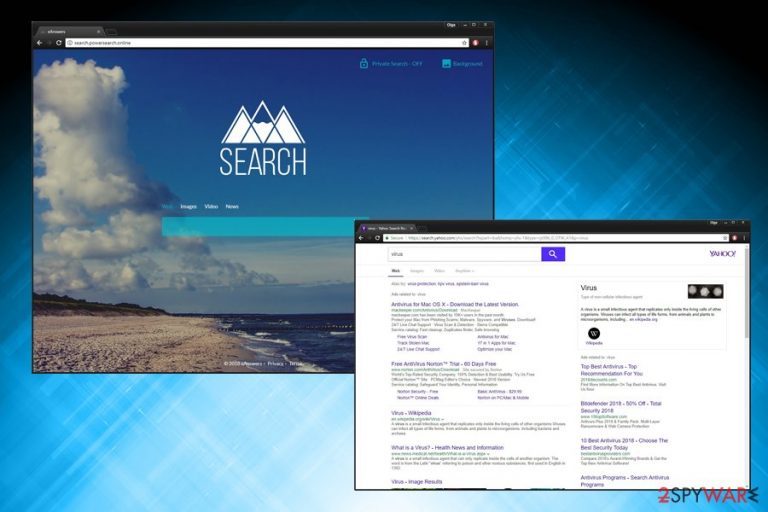Search.powersearch.online (Removal Guide) - Free Instructions
Search.powersearch.online Removal Guide
What is Search.powersearch.online?
Search.powersearch.online is a dubious search engine that contains links to third-party websites

Search.powersearch.online is a browser hijacker[1] that comes from eAnswers family. Its primary purpose is to hijack Google Chrome, Internet Explorer, Safari, Mozilla Firefox or another browser by modifying settings and then displaying invasive ads, redirecting users to questionable sites and gathering certain data about them. Although a browser hijacker is not malware, the features mentioned above can certainly compromise the machine and expose users to various virus threats.
| SUMMARY | |
| Name | Search.powersearch.online |
| Type | Browser hijacker |
| Browser extension | MyPrivateSearch |
| Created by | eAnswers |
| Distribution | Software bundling |
| Main dangers | Malware infiltration, stolen personal data |
| Elimination | Download and install FortectIntego; otherwise, check our step-by-step guide below |
Search.powersearch.online looks identical to other browser hijackers created by eAnswers – Search.myappzcenter.com, Search.theappzworld.com, Search.medianetnow.com and multiple others. Developers try to attract people with five beautiful backgrounds and sleek design of the main page. Additionally, they offer the “Private Search” option which allows users to allegedly filter adult and other explicit content from search results. Apparently, this option becomes available once MyPrivateSearch browser extension is added to the browser.
Nevertheless, all these features are presented so that users would get the sense of legitimacy and usefulness. In reality, Search.powersearch.online removal should be executed as soon as possible as its only goal is to monetize on a miserable browsing experience of its users.
As soon as Search.powersearch.online hijack occurs, the address of new tab, startup page and search engine of the browser is set to hxxp://search.powersearch.online. These changes cannot be set back to the preferred ones unless the browser hijacker is uninstalled.
Also, all search results are redirected to hxxps://search.yahoo.com. Although Yahoo is a legitimate search engine, the search results generated through Search.powersearch.online are altered and not genuine. Users will see a layer of sponsored links that lead to affiliated websites. In some cases, links can be legitimate and lead to well-known sites. However, users might also be redirected to suspicious or even malware-laden domains.
It goes without saying that such activity might damage users’ PCs or, if a keylogger[2] is installed, it might steal personal information, and the user will not even know about it. As a result, identity fraud is a plausible outcome.
Search.powersearch.online virus also gathers non-personally identifiable information in order to create a digital ID and then display targeted advertising based on users’ browsing habits. The accumulated data includes:
- IP address;
- ISP;
- Browser type;
- Cookie information;
- Sites visited;
- Search queries, etc.
To conclude, a browser hijacker is not useful and can expose users to severe dangers online. Thus, you should remove Search.powersearch.online either using reputable security software (FortectIntego, or any other) or by checking manual guide below this post.

Never pick Recommended or Quick settings when installing free software
Users are typically quite careless when it comes to internet safety. Thus, they rush installation of freeware by skipping steps and never reading terms and conditions. Initially, it is a huge mistake and typically results in infiltration of unwanted software. Therefore, do not try to save a couple of minutes of time by rushing the process.
Security experts[3] recommend the following:
- Only download applications from legitimate sources;
- Avoid third-party sites, especially file-sharing of peer-2-peer domains;
- Before installing a new app, read reviews online (such as blogs, forums, security articles, etc.);
- When prompted, always opt for Advanced or Custom installation mode;
- If you encounter any optional installs, avoid the infiltration by removing tick marks next to add-ons, toolbars, search engines, etc.
Uninstall Search.powersearch.online safely
Search.powersearch.online removal can be performed either manually or automatically – both of these methods are viable. If you decide to go for manual PUP elimination, you should check our guide below this article. Make sure, however, that you understand all the instructions properly before continuing.
We suggest you remove Search.powersearch.online automatically if you want a quick solution. Merely pick on of the security programs we recommend and scan your system. This process should only take few minutes and will detect and eliminate all the unwanted components quickly.
You may remove virus damage with a help of FortectIntego. SpyHunter 5Combo Cleaner and Malwarebytes are recommended to detect potentially unwanted programs and viruses with all their files and registry entries that are related to them.
Getting rid of Search.powersearch.online. Follow these steps
Uninstall from Windows
To eliminate MyPrivateSearch from Windows OS, follow this guide:
Instructions for Windows 10/8 machines:
- Enter Control Panel into Windows search box and hit Enter or click on the search result.
- Under Programs, select Uninstall a program.

- From the list, find the entry of the suspicious program.
- Right-click on the application and select Uninstall.
- If User Account Control shows up, click Yes.
- Wait till uninstallation process is complete and click OK.

If you are Windows 7/XP user, proceed with the following instructions:
- Click on Windows Start > Control Panel located on the right pane (if you are Windows XP user, click on Add/Remove Programs).
- In Control Panel, select Programs > Uninstall a program.

- Pick the unwanted application by clicking on it once.
- At the top, click Uninstall/Change.
- In the confirmation prompt, pick Yes.
- Click OK once the removal process is finished.
Delete from macOS
Remove items from Applications folder:
- From the menu bar, select Go > Applications.
- In the Applications folder, look for all related entries.
- Click on the app and drag it to Trash (or right-click and pick Move to Trash)

To fully remove an unwanted app, you need to access Application Support, LaunchAgents, and LaunchDaemons folders and delete relevant files:
- Select Go > Go to Folder.
- Enter /Library/Application Support and click Go or press Enter.
- In the Application Support folder, look for any dubious entries and then delete them.
- Now enter /Library/LaunchAgents and /Library/LaunchDaemons folders the same way and terminate all the related .plist files.

Remove from Microsoft Edge
Delete unwanted extensions from MS Edge:
- Select Menu (three horizontal dots at the top-right of the browser window) and pick Extensions.
- From the list, pick the extension and click on the Gear icon.
- Click on Uninstall at the bottom.

Clear cookies and other browser data:
- Click on the Menu (three horizontal dots at the top-right of the browser window) and select Privacy & security.
- Under Clear browsing data, pick Choose what to clear.
- Select everything (apart from passwords, although you might want to include Media licenses as well, if applicable) and click on Clear.

Restore new tab and homepage settings:
- Click the menu icon and choose Settings.
- Then find On startup section.
- Click Disable if you found any suspicious domain.
Reset MS Edge if the above steps did not work:
- Press on Ctrl + Shift + Esc to open Task Manager.
- Click on More details arrow at the bottom of the window.
- Select Details tab.
- Now scroll down and locate every entry with Microsoft Edge name in it. Right-click on each of them and select End Task to stop MS Edge from running.

If this solution failed to help you, you need to use an advanced Edge reset method. Note that you need to backup your data before proceeding.
- Find the following folder on your computer: C:\\Users\\%username%\\AppData\\Local\\Packages\\Microsoft.MicrosoftEdge_8wekyb3d8bbwe.
- Press Ctrl + A on your keyboard to select all folders.
- Right-click on them and pick Delete

- Now right-click on the Start button and pick Windows PowerShell (Admin).
- When the new window opens, copy and paste the following command, and then press Enter:
Get-AppXPackage -AllUsers -Name Microsoft.MicrosoftEdge | Foreach {Add-AppxPackage -DisableDevelopmentMode -Register “$($_.InstallLocation)\\AppXManifest.xml” -Verbose

Instructions for Chromium-based Edge
Delete extensions from MS Edge (Chromium):
- Open Edge and click select Settings > Extensions.
- Delete unwanted extensions by clicking Remove.

Clear cache and site data:
- Click on Menu and go to Settings.
- Select Privacy, search and services.
- Under Clear browsing data, pick Choose what to clear.
- Under Time range, pick All time.
- Select Clear now.

Reset Chromium-based MS Edge:
- Click on Menu and select Settings.
- On the left side, pick Reset settings.
- Select Restore settings to their default values.
- Confirm with Reset.

Remove from Mozilla Firefox (FF)
Remove dangerous extensions:
- Open Mozilla Firefox browser and click on the Menu (three horizontal lines at the top-right of the window).
- Select Add-ons.
- In here, select unwanted plugin and click Remove.

Reset the homepage:
- Click three horizontal lines at the top right corner to open the menu.
- Choose Options.
- Under Home options, enter your preferred site that will open every time you newly open the Mozilla Firefox.
Clear cookies and site data:
- Click Menu and pick Settings.
- Go to Privacy & Security section.
- Scroll down to locate Cookies and Site Data.
- Click on Clear Data…
- Select Cookies and Site Data, as well as Cached Web Content and press Clear.

Reset Mozilla Firefox
If clearing the browser as explained above did not help, reset Mozilla Firefox:
- Open Mozilla Firefox browser and click the Menu.
- Go to Help and then choose Troubleshooting Information.

- Under Give Firefox a tune up section, click on Refresh Firefox…
- Once the pop-up shows up, confirm the action by pressing on Refresh Firefox.

Remove from Google Chrome
You need to reset Google Chrome to default:
Delete malicious extensions from Google Chrome:
- Open Google Chrome, click on the Menu (three vertical dots at the top-right corner) and select More tools > Extensions.
- In the newly opened window, you will see all the installed extensions. Uninstall all the suspicious plugins that might be related to the unwanted program by clicking Remove.

Clear cache and web data from Chrome:
- Click on Menu and pick Settings.
- Under Privacy and security, select Clear browsing data.
- Select Browsing history, Cookies and other site data, as well as Cached images and files.
- Click Clear data.

Change your homepage:
- Click menu and choose Settings.
- Look for a suspicious site in the On startup section.
- Click on Open a specific or set of pages and click on three dots to find the Remove option.
Reset Google Chrome:
If the previous methods did not help you, reset Google Chrome to eliminate all the unwanted components:
- Click on Menu and select Settings.
- In the Settings, scroll down and click Advanced.
- Scroll down and locate Reset and clean up section.
- Now click Restore settings to their original defaults.
- Confirm with Reset settings.

Delete from Safari
Remove unwanted extensions from Safari:
- Click Safari > Preferences…
- In the new window, pick Extensions.
- Select the unwanted extension and select Uninstall.

Clear cookies and other website data from Safari:
- Click Safari > Clear History…
- From the drop-down menu under Clear, pick all history.
- Confirm with Clear History.

Reset Safari if the above-mentioned steps did not help you:
- Click Safari > Preferences…
- Go to Advanced tab.
- Tick the Show Develop menu in menu bar.
- From the menu bar, click Develop, and then select Empty Caches.

After uninstalling this potentially unwanted program (PUP) and fixing each of your web browsers, we recommend you to scan your PC system with a reputable anti-spyware. This will help you to get rid of Search.powersearch.online registry traces and will also identify related parasites or possible malware infections on your computer. For that you can use our top-rated malware remover: FortectIntego, SpyHunter 5Combo Cleaner or Malwarebytes.
How to prevent from getting stealing programs
Stream videos without limitations, no matter where you are
There are multiple parties that could find out almost anything about you by checking your online activity. While this is highly unlikely, advertisers and tech companies are constantly tracking you online. The first step to privacy should be a secure browser that focuses on tracker reduction to a minimum.
Even if you employ a secure browser, you will not be able to access websites that are restricted due to local government laws or other reasons. In other words, you may not be able to stream Disney+ or US-based Netflix in some countries. To bypass these restrictions, you can employ a powerful Private Internet Access VPN, which provides dedicated servers for torrenting and streaming, not slowing you down in the process.
Data backups are important – recover your lost files
Ransomware is one of the biggest threats to personal data. Once it is executed on a machine, it launches a sophisticated encryption algorithm that locks all your files, although it does not destroy them. The most common misconception is that anti-malware software can return files to their previous states. This is not true, however, and data remains locked after the malicious payload is deleted.
While regular data backups are the only secure method to recover your files after a ransomware attack, tools such as Data Recovery Pro can also be effective and restore at least some of your lost data.
- ^ Browser hijacking. Wikipedia. The free encyclopedia.
- ^ What is a Keylogger?. McAfee. Security researchers.
- ^ Avirus. Avirus. Hungarian cybersecurity news and articles.
